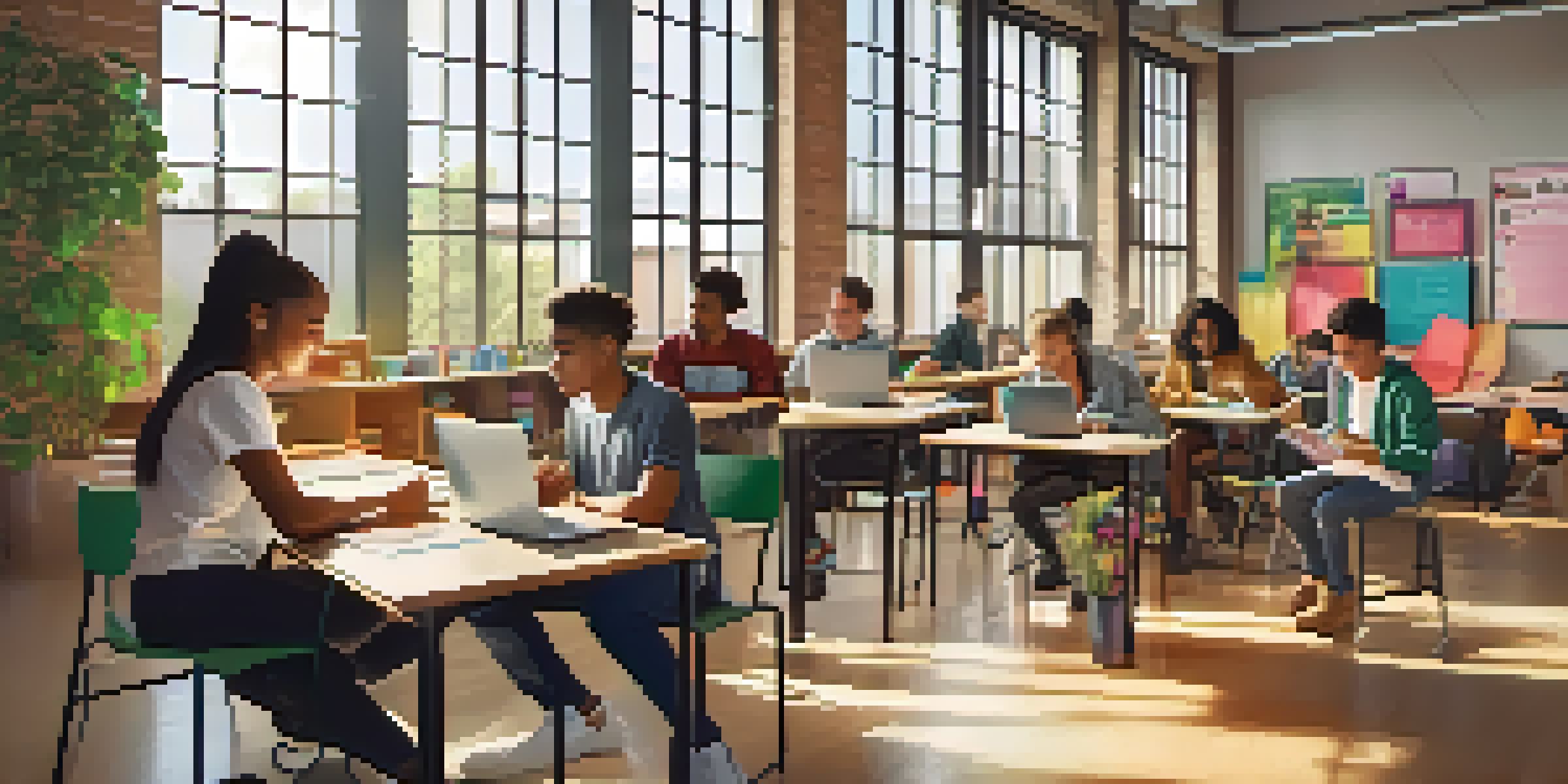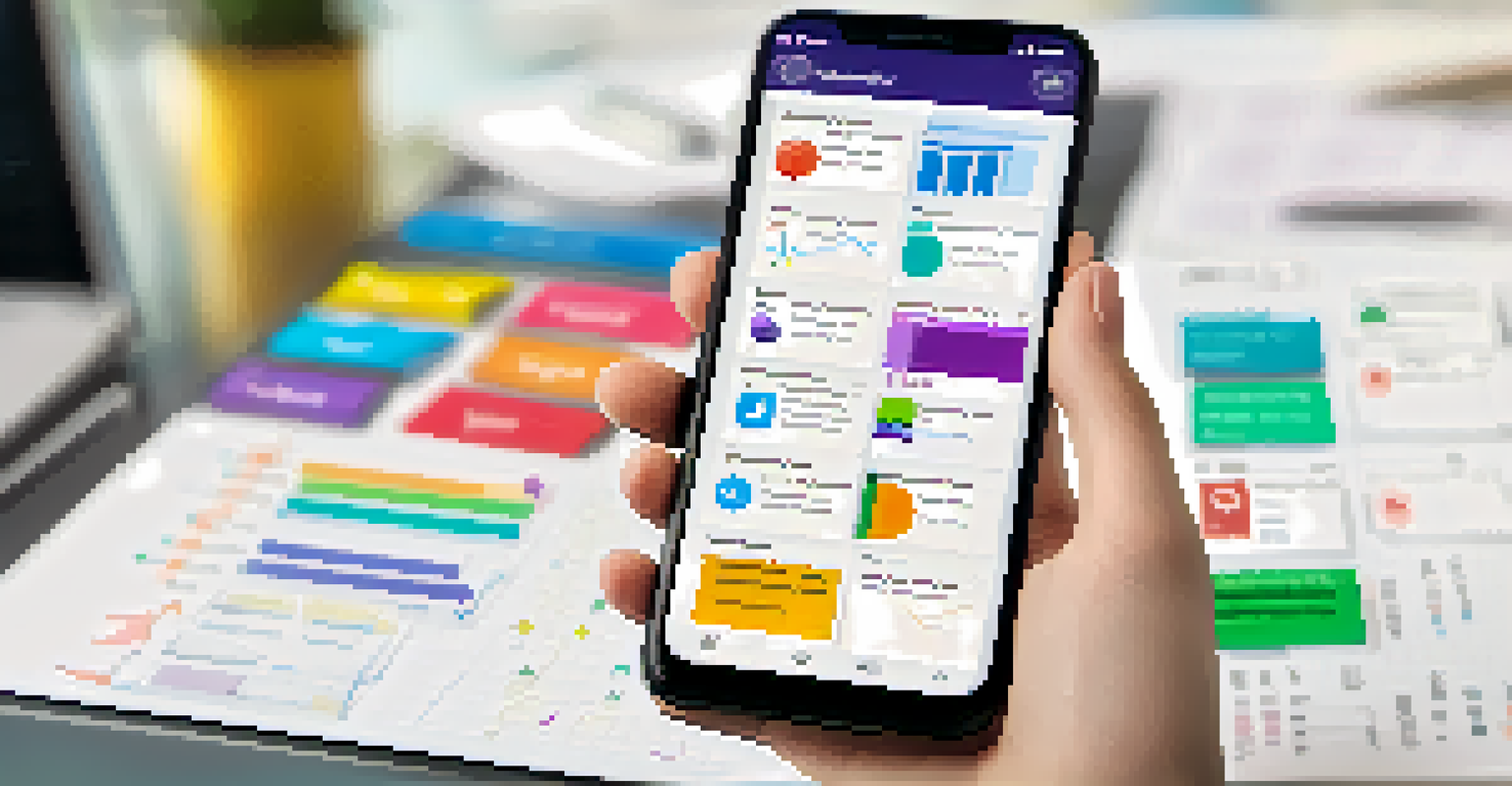Using Mobile Technology to Facilitate Group Learning

Understanding Group Learning in the Digital Age
Group learning has evolved significantly with the rise of technology. It now encompasses various methods that encourage collaboration, social interaction, and shared knowledge. In this context, mobile technology plays a pivotal role, offering tools that facilitate communication and engagement among learners.
Technology is best when it brings people together.
Whether it's through messaging apps, social media platforms, or collaborative apps, students can connect and share ideas instantly. This immediacy helps to break down geographical barriers, allowing diverse groups to work together seamlessly. As we delve into mobile technology's impact on group learning, we'll see how these tools can enhance educational experiences.
Ultimately, the integration of mobile technology into group learning environments can lead to richer discussions and deeper understanding. By leveraging these tools, educators can create a more inclusive and dynamic learning atmosphere that benefits everyone involved.
Key Mobile Tools for Collaborative Learning
There are several mobile tools available that can significantly enhance group learning. Applications like Google Docs, Slack, and Trello allow students to collaborate in real-time, making it easier to share resources and feedback. These platforms not only streamline communication but also foster a sense of community among learners.

For instance, using Google Docs, a group can work on a project simultaneously, making edits and suggestions without the need for constant meetings. This flexibility empowers students to learn at their own pace while still contributing to group objectives. Tools like these transform the traditional classroom experience into an interactive and participatory environment.
Mobile Tools Enhance Collaboration
Applications like Google Docs and Slack facilitate real-time collaboration, making it easier for students to share resources and feedback.
Moreover, mobile technology enables access to learning materials anytime and anywhere, which is crucial for group projects. By utilizing these tools effectively, students can stay connected and organized, ensuring that everyone is on the same page and contributing equally to the group's success.
Fostering Communication and Engagement
Effective communication is at the heart of successful group learning. Mobile technology facilitates this by providing various channels for discussion, such as group chats, video calls, and forums. These tools enable students to engage with one another in ways that traditional classrooms often cannot accommodate.
The beautiful thing about learning is that no one can take it away from you.
When students can communicate freely and share their thoughts without the pressure of formal settings, they tend to be more open and creative. This fosters an environment where ideas can flow freely, leading to innovative solutions and deeper insights. Engaging in discussions via mobile technology can thus enhance critical thinking and problem-solving skills among group members.
Moreover, the ability to communicate instantly helps in resolving conflicts and misunderstandings that may arise during collaborative efforts. By addressing issues promptly through mobile channels, groups can maintain a positive and productive atmosphere, ultimately leading to better learning outcomes.
Promoting Accountability and Organization
Mobile technology can significantly improve accountability among group members. Tools like task management apps help assign roles and track progress, ensuring that everyone knows their responsibilities. This level of organization is crucial for maintaining momentum and ensuring that projects stay on schedule.
For example, platforms like Asana or Notion allow groups to create to-do lists, set deadlines, and monitor completion statuses. This transparency encourages students to take ownership of their tasks, knowing that their contributions are visible to others. As a result, accountability becomes a shared value that enhances group dynamics.
Effective Communication Drives Success
Mobile technology provides various channels for discussion, fostering an environment where students can engage freely and creatively.
Furthermore, having a structured approach to collaborative projects can reduce stress and confusion. When everyone is aware of their tasks and deadlines, it allows for smoother collaboration and a more enjoyable learning experience. Thus, mobile technology not only facilitates communication but also promotes a sense of responsibility among learners.
Enhancing Accessibility for Diverse Learners
One of the greatest advantages of mobile technology in group learning is its ability to enhance accessibility. Students with varying needs can benefit from tools that accommodate different learning styles and preferences. For instance, audio and visual resources can be easily shared through mobile platforms, catering to auditory and visual learners alike.
Additionally, mobile technology can help those who may struggle with traditional learning methods. Features such as speech-to-text or translation apps can break down barriers for learners with disabilities or language challenges. This inclusivity allows all students to participate meaningfully in group activities, enriching the learning experience for everyone involved.
By ensuring that all students have access to the same resources and opportunities, mobile technology creates a more equitable learning environment. This not only fosters collaboration but also encourages empathy and understanding among group members, leading to stronger interpersonal connections.
Encouraging Peer Feedback and Support
Peer feedback is an essential component of group learning, and mobile technology can facilitate this process seamlessly. Students can use apps to provide constructive criticism on each other's work, which helps to develop their analytical skills. This kind of collaboration fosters a culture of support and shared learning among peers.
For example, platforms like Padlet or Flipgrid allow students to showcase their projects and receive feedback from their peers. This interactive approach not only boosts confidence but also encourages students to think critically about their own work. The more feedback they receive, the more they can refine their ideas and improve their skills.
Accessibility Promotes Inclusivity
Mobile tools accommodate diverse learning needs, ensuring all students can participate meaningfully in group activities.
Additionally, mobile technology allows for asynchronous feedback, meaning students can provide input at their convenience. This flexibility encourages more thoughtful and thorough responses, as learners can take their time to reflect on their peers' work. Ultimately, this peer-to-peer interaction enhances the overall learning experience.
Measuring Success in Group Learning with Tech
Assessing the effectiveness of group learning can be challenging, but mobile technology offers innovative solutions. Educators can use analytics tools to track participation, engagement, and overall performance in group projects. This data-driven approach provides valuable insights into how well students are collaborating.
For instance, platforms like Kahoot! can be utilized to create quizzes that measure group knowledge retention. By analyzing the results, educators can identify areas where students may need additional support or resources. This ensures that instruction is tailored to meet the needs of the group, enhancing the learning experience.

Moreover, feedback from students about their experiences can also be gathered through mobile surveys or forms. This input can help educators refine their approaches and tools for future group learning sessions. Ultimately, measuring success with mobile technology allows for continuous improvement in both teaching and learning.